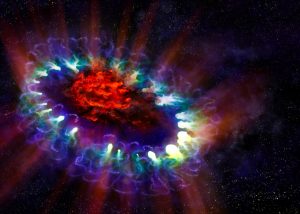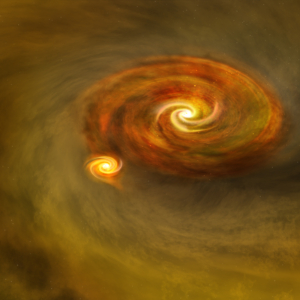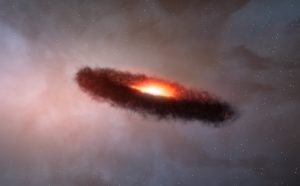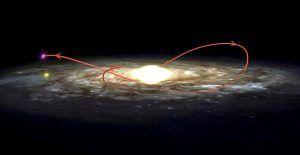The complex explosion and gas collisions in nova V959 Mon is illustrated here. In the first days of the nova explosion, dense, relatively slow-moving material is expelled along the binary star system’s equator (yellow material in left panel). Over the next several weeks, fast winds pick up and are blown off the binary, but they are funneled along the binary star system’s poles (blue material in central panel). The equatorial and polar material crashes together at their intersection, producing shocks and gamma-ray emission (red regions in central panel). Finally, at later times, the nova stops blowing a wind, and the material drifts off into space, the fireworks finished (right panel).


Dust Bowl of Supernova 1987A
This artist’s illustration of supernova 1987A reveals the cold, inner regions of the exploded star’s remnants (red) where tremendous amounts of dust were detected and imaged by ALMA. This inner region is contrasted with the outer shell (blue), where the energy from the supernova is colliding (green) with the envelope of gas ejected from the star prior to its powerful detonation.

Binary Star Formation
Binary star formation through disk fragmentation starts with a young star surrounded by a rotating disk of gas and dust. The disk fragments, with a second star forming within the disk, surrounded by its own disk. The two stars form an orbiting pair.

Starless Cloud Cores
This image shows the ALMA data overlaid on an artist’s impression background. The ALMA data show two main cores as imaged by emission from the molecular ion N2D+ (two nitrogen and one deuterium atom). The core on the right is particularly bright and rounded, suggesting it is self-gravitating and poised to form a massive, single star – a very rare occurrence in star formation. The other core appears more distorted and fragmented, potentially leading to the formation of multiple lower-mass stars. This fragmentation is a normal process in star-forming clouds.

Artist’s impression of the disc of dust and gas around a brown dwarf
This artist’s impression shows the disc of gas and cosmic dust around a brown dwarf. Rocky planets are thought to form through the random collision and sticking together of what are initially microscopic particles in the disc of material around a star. These tiny grains, known as cosmic dust, are similar to very fine soot or sand. Astronomers using the Atacama Large Millimeter/submillimeter Array (ALMA) have for the first time found that the outer region of a dusty disc encircling a brown dwarf — a star-like object, but one too small to shine brightly like a star — also contains millimetre-sized solid grains like those found in denser discs around newborn stars. The surprising finding challenges theories of how rocky, Earth-scale planets form, and suggests that rocky planets may be even more common in the Universe than expected.

Tracking a Black Hole
Orbital path (red line) of black hole XTE J1118+480 and its companion through the Milky Way Galaxy over the past 230 million years. Yellow circle indicates the Sun’s current position.





